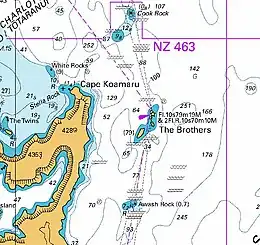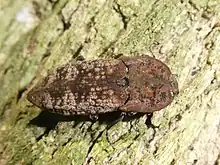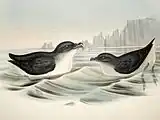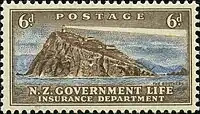Ngāwhatu-kai-ponu | |
|---|---|
 North Brother (left) and South Brother | |
 Extract from Chart NZ 46 Cook Strait | |
| Geography | |
| Coordinates | 41°06′50″S 174°25′59″E / 41.114°S 174.433°E |
| Major islands | South Brother, North Brother |
| Area | 0.17 km2 (0.066 sq mi) |
| Highest elevation | 66 m (217 ft) |
| Administration | |
| Demographics | |
| Population | 0 |
The Brothers (Māori: Ngāwhatu-kai-ponu) is a group of small islands in Cook Strait, New Zealand, off the east coast of Cape Koamaru, Arapaoa Island. The islands are a restricted-access wildlife sanctuary administered by the Department of Conservation.[1]
Islands
The Brothers form two small island groups, each containing one main island and a number of tiny islets. The main islands are simply called North Brother and South Brother. South Brother is the larger of the two, covering some 9.5 hectares (23 acres), but the 4-hectare (9.9-acre) North Brother is slightly more elevated, rising to 66 metres (217 ft).[2] Most of the smaller islets lie in a small arc south of North Brother, with the largest being only some one hectare in area.
History
The Māori name for the group, Ngāwhatu-kai-ponu, literally means "the eyes that witnessed" and according to tradition it refers to the eyeballs of the giant octopus, Te Wheke-a-Muturangi, that Kupe battled. The islets were considered tapu to Māori. Paddlers making their first crossing of Raukawa/Cook Strait were blindfolded as it was considered bad luck to see the islands on their first crossing.[3][4]
During Captain James Cook's first visit to the area, HMS Endeavour was very nearly wrecked on the Brothers, as a lack of wind and strong tide drove the ship towards the rocks. A change in the direction of the tide saved the ship.[4][5]
Lighthouse
The Brothers Island lighthouse is located on the summit of North Brother. The lighthouse was built in 1877 and is New Zealand's only rock station.[3] It replaced the Mana Island lighthouse. [1]
The first call for a lighthouse on the Brothers was in 1851 after the Maria sank near Cape Terawhiti.[6] When a lighthouse was erected on Mana Island to serve Cook Strait comment was made in the Marlborough Press that despite the expense it would have been better to have put one on the Brothers.[7] This request was again repeated in the Evening Post in 1870.[8] In 1867 SS Queen sank after hitting Cook's Rock, just to the north of the Brothers;[9] Cook's Rock was lit by a red light once the lighthouse opened.[10] In 1872 the barque City of Newcastle was lost because the Captain mistook the Mana Island light for the entrance to Wellington Harbour.[11] In 1874 a report titled New Zealand Coast Lights by Captain Johnson was tabled in Parliament and, among others, recommended removing the Mana Island light in favour of a light on the Brothers.[12][13]
Construction of the lighthouse was difficult because of its isolation and lack of fresh water. Building materials for construction were unable to be delivered to the island for 2 months because of the weather and sea conditions. Workers had to construct huts as tents could not be pitched on the rock.[1] The oil powered light began operation on 24 September 1877. This was replaced in August 1954 to electricity supplied by a 10hp diesel engine coupled to three 6.8kw generators. A further upgrade occurred in August 1990 when the light was switched to a 50 watt tungsten halogen solar powered beacon and fully automated.[1][5]
The light was kept by a lighthouse keeper until August 1990. Since then the light has been remotely monitored from Wellington. The lights isolation was very hard on the keepers and supplying the island challenging. Supplies were bought in from Picton and the lighthouse keepers provided weather reports on local conditions at 4.30 am daily, then every hour on the hour till 4 pm.[1][5]
Endangered species
 Cook Strait Click Beetle
Cook Strait Click Beetle Diving Petrel
Diving Petrel.jpg.webp) Kirkianella novae-zealandiae.
Kirkianella novae-zealandiae..jpg.webp) Tuatara.
Tuatara.
In 1970 The Brothers were declared a sanctuary. North Brother Island is a sanctuary for a rare reptile subspecies, the Brothers Island tuatara (Sphenodon punctatus guntheri), and is the type locality for a rare beetle species, the Cook Strait click beetle (Amychus granulatus), although the latter is possibly extinct there now.[14][5]
Others include the diving petrel and the extremely rare dandelion looking plant Kirkianella novae-zealandiae. This plant is only found on North Brother Island and Arapaoa Island. Department of Conservation staff visit the island about four times a year to remove invasive species to protect these and other endangered species.[15]
Other

The Brothers lighthouse featured on one of the 1947 New Zealand Government Life Insurance Department lighthouse series postage stamps.
See also
References
- 1 2 3 4 5 Brothers Island Lighthouse, Maritime New Zealand, retrieved 19 May 2023
- ↑ Topographical map
- 1 2 McKinnon, M. "Arapawa Island to Port Underwood", Te Ara - the Encyclopedia of New Zealand. 18 Jun 2015. Accessed 15 September 2018.
- 1 2 Ngāwhatu Kai-ponu/The Brothers, Christopher Cookson, Marlboroughonline.co.nz, 27 March 2020 15:26, retrieved 19 May 2023
- 1 2 3 4 The Brothers Islands and Lighthouse, an adaption from a Loreen Brehaut article for the Seaport News 2010 and update May 2020, retrieved 19 May 2023
- ↑ "ORIGINAL CORRESPONDENCE - To the editor of the Wellington Independent". Wellington Independent. No. 604. 26 July 1851. p. 3. Retrieved 19 May 2023 – via paperspast.natlib.govt.nz.
- ↑ "Local and General News - Coast Lights". Wellington Independent. No. 2105. 17 September 1864. p. 3. Retrieved 19 May 2023 – via paperspast.natlib.govt.nz.
- ↑ "TUESDAY, APRIL 19, 1870 - Editorial". The Evening Post. No. 55. 19 April 1870. p. 2. Retrieved 19 May 2023 – via paperspast.natlib.govt.nz.
- ↑ "LOSS OF THE N.Z.S.N. CO.'s S.S. QUEEN. Press". paperspast.natlib.govt.nz. 12 April 1867. Retrieved 7 July 2023.
- ↑ "Twelfth Report of the Marine Department for the year ended 30th June, 1877". atojs.natlib.govt.nz. Retrieved 7 July 2023.
- ↑ "WRECK OF THE BARQUE CITY OF NEWCASTLE". Wellington Independent. No. 3657. 18 November 1872. p. 2. Retrieved 19 May 2023 – via paperspast.natlib.govt.nz.
- ↑ "New Zealand Coast Lights". Wellington Independent. No. 4075. 10 April 1874. p. 3. Retrieved 19 May 2023 – via paperspast.natlib.govt.nz.
- ↑ "Parliament - 24 May 1874 - Lighthouses". New Zealand Mail. No. 165. 29 August 1874. p. 2. Retrieved 19 May 2023 – via paperspast.natlib.govt.nz.
- ↑ Marris, John W. M.; Johnson, Paul J. (2010). "A revision of the New Zealand click beetle genus AmychusPascoe 1876 (Coleoptera: Elateridae: Denticollinae) with a description of a new species from the Three Kings Islands". Zootaxa. 2331: 35–56. Retrieved 29 May 2016.
- ↑ North Brother Island little more than a rock, but an important rock, Wendy Sullivan, Stuff.co.nz, 04:00 11 May 2017, retrieved 19 May 2023
External links
- Brothers Island Lighthouse at Maritime New Zealand